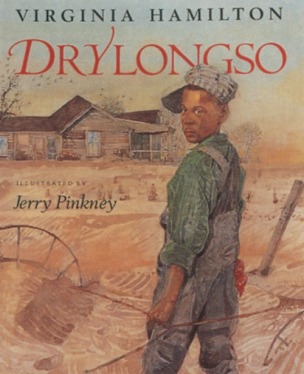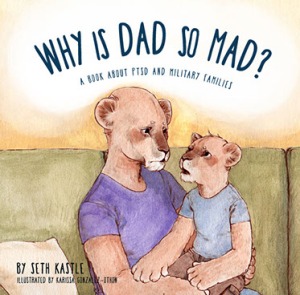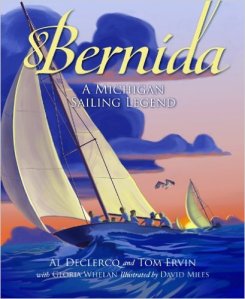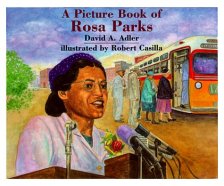I’m a tall person. It is hard for me to easily control the second half of my body. When I was in the Youth section of the library the other day to pick up these books, a little pug nosed brat kid carelessly ran into my legs. And then the library person who does stuff behind a desk gave me a stink eye. Like, “How dare you stand in the way of a kid misbehaving!” There are probably three women who work in the Youth section of the library…but they’re all white and they all wear ponytails so I can never tell who’s who.
Anyway…this has been so much FUN!
Drylongso (1992) by Virginia Hamilton / Illustrated by Jerry Pinkney: Drylongso is more of a novella than a traditional “picture book.” It’s sort of the same size as Sarah, Plain, and Tall. You can easily read it in one sitting…but you can’t just easily flip through it like other picture books. There’s a lot of text. The story takes place during a major 1970’s drought, and the effect it has on a farming family in Mississippi. A mysterious young man named Drylongso comes to them during a major dust storm, and shows them how to drill for water from the Earth. I am familiar with some of Virginia Hamilton’s other works (MC Higgins, Junior Brown). I know she is sort of polarizing. Despite MC Higgins winning a Newbery, it has a uncharacteristically low score on goodreads. And I sort of understand why. Her text can be a bit dry sometimes, and her stories aren’t always “EXCITING!” with a capital “E.” Drylongso isn’t much different. If I were a child, I probably wouldn’t enjoy Drylongso too much. It would be hard for me to follow what was going on. As a 24 year old…I still can’t say reading this 50 page book was the highpoint of my day. However, I can appreciate the story. I can appreciate what Hamilton did in turning an old southern phrase (“Drylongso”) into this sort of magic realist creature. I can appreciate how Hamilton takes her time in creating a setting, and allowing the audience to visualize it. And I’ll always appreciate Jerry Pinkney’s illustrations, who really did a wonderful job of “dusting” each panel for full effect. Virginia Hamilton is one of the most respected African American novelists. If you want you kids to be introduced to her and her style of writing, Drylongso could be a good place to start.
Boundless Grace (1995) by Mary Hoffman / Pictures by Caroline Binch: So, in my last post, I reviewed Amazing Grace. And I wrote that I was interested in reading some of the other “Grace” books. Well, I found the sequel: Boundless Grace. I don’t think I ever read this book as a child, but I wish I had. As someone with 2 parents from Nigeria, it’s nice seeing a book that is mostly set in Africa (more specifically, Gambia). In this book, we learn a bit more about Grace. She lives with her mom and grandma. Her father split up with her mother when Grace was very little, and he now lives in Gambia with a new family. When Grace flies to Gambia to visit her father, she has a hard time adjusting and accepting this other family, particularly her father’s wife, who she thinks will be an evil stepmother like her story books. It’s a very interesting book about split/alternative families, and the idea that the “perfect family” is what you make of it. Also, it’s one of those rare children’s books that shows a relatively modern view of African culture. I hope to find the other Grace books in the future.
Why Is Dad So Mad?: A Book About PTSD and Military Families (2015) by Seth Kastle / Illustrated by Karissa Gonzalez-Othon: This isn’t the only/first picture about PTSD; however, there is a simplicity and bare-bones quality that is quite refreshing. The book uses a family of lions to illustrate the issues that can arise when a father comes back home after serving in the army. I’m not sure if the illustrations will be winning any awards, but Gonzalez-Othon does a nice job of portraying anger, fear, and love through the pictures. And while the text is unextroadinary, it’s very effective and straightforward, and I think that’s all you need for a book like this. Seth Kastle is an Army vet, and it’s great how he is creating this resource for kids across the country. And, there’s a version out there about Army moms, so that’s nice. Families can choose the book that’s most relevant to them.
The Red Bicycle: The Extraordinary Story of One Ordinary Bicycle (2015) By Jude Isabella / Illustrated by Simone Shin: I really really liked this one. It’s a story in three parts. The first story is about an American boy who saves up to buy the bike of his dreams. However, after a few years, he outgrows the bike and graciously donates the bike to an organization that sends used bikes to places in Africa where bikes are a major source of transportation. The second part takes place in Burkina Faso, and is about a girl who uses that bike for daily errands. However, she grows too old for the bike too. So, she donates it to a hospital, who uses the bike for emergency transportation. The main purpose of this book is to encourage kids to donate their bikes; however, the story also has a powerful message on giving, sharing, and the power of worldwide connection. It shows that even the simplest of deeds can change the world. The American boy probably never imagined that his bike would be used to save lives. The illustrations are simple, yet big, bright, and colorful. This book is part of a publication press that publishes books that helps kids become “better global citizens.” I’m all for that. I hope to read more books from this series, because I really liked this one.
Bernida: A Michigan Sailing Legend (2014) by Al Declercq and Tom Ervin with Gloria Whelan / Illustrated by David Miles: As a Michigander, it’s nice to see a picture book about Michigan. I’m not sure if anyone outside of Michigan would truly be interested in this book, but that’s not a bad thing. This book was made for the Michigan kid to learn more about his or her heritage and history. This is a story of how a winning sailboat, Bernida, survived from the 1920’s to 2012 to win a sailing competition. Similar to The Red Bicycle, it kind of shows how much power and personality an inanimate object can possess. I really liked the illustrations; there’s something so animated/cartoony about them. It’s as if I was watching a movie.
The Lunch Thief (2010) by Anne C. Bromley / Illustrated by Robert Casilla: This story is about a boy named Rafael, whose lunch is stolen by the new kid Kevin Kopeck. At first, Rafael is angry; however, when he learns that Kevin and his mother live in a motel room as a result of a neighborhood fire, he soon empathizes with Kevin and offers to share his lunch with him. There’s a lot of nice things about this book. I like how Rafael makes rational decisions throughout the text, instead of doing the easy thing: which would be to get angry or violent. I like how this book teaches kids to be empathetic of other people’s issues (if only some politicians felt this way). However, I almost wish this book had been a little longer. I appreciate the simplicity, and the ending is cute…but a part of me sort of wishes Kevin had apologized for stealing Rafael’s lunch. I just feel like kids reading this book may the get the wrong idea; not fully understanding why Kevin steals lunches, they may start to believing stealing is OK. But, my feelings on that mixed. I’d still recommend this book.
A Picture Book of Rosa Parks (1993) by David A. Adler / Illustrated by Robert Casilla: So, for my very first post, I wrote about A Picture Book of Eleanor Roosevelt, which was written by the same team here. I also reviewed another book on Rosa Parks. So, I guess it only made sense for me to review A Picture Book of Rosa Parks. It seems like every picture book about Rosa Parks covers the same check marks (I’ve read three in the last year). So, I guess it’s just up to an educator to choose which book is right for his or her classroom. However, this book was published twelve years before Parks died, so maybe a more contemporary book would be better.
In The Night Kitchen (1970) by Maurice Sendak: Let’s end this edition of “Creeping” with a controversial classic. I actually specifically sought this book out because I remember watching the short film version when I was very little and being completely weirded out by it. Why did those bakers think Mickey was milk? Why did they want to cook him? Although this book won a Caldecott Honor, it was controversial because, yes, we do get a few panels of Mickey’s wittle wenis. But, I can see how they book was still awarded because the illustrations are so good. A kid could really read this for an hour and discover all the details (like the boxes of food mixes that act as a background). I actually like these illustrations more than Where the Wild Things Are. Why couldn’t Spike Jonze make a movie version out of this?? Anyway, when I read this book (and when I watched the movie when I was little), I always thought the bakers represented child abductors/child molesters. However, Sendak’s interpretation seems to be about the Holocaust (like the Bakers trying to put Mickey in the oven). In any case, those bakers are weird, creepy, and NOT good people at all! Stay away from bakers!
Byeeee.







